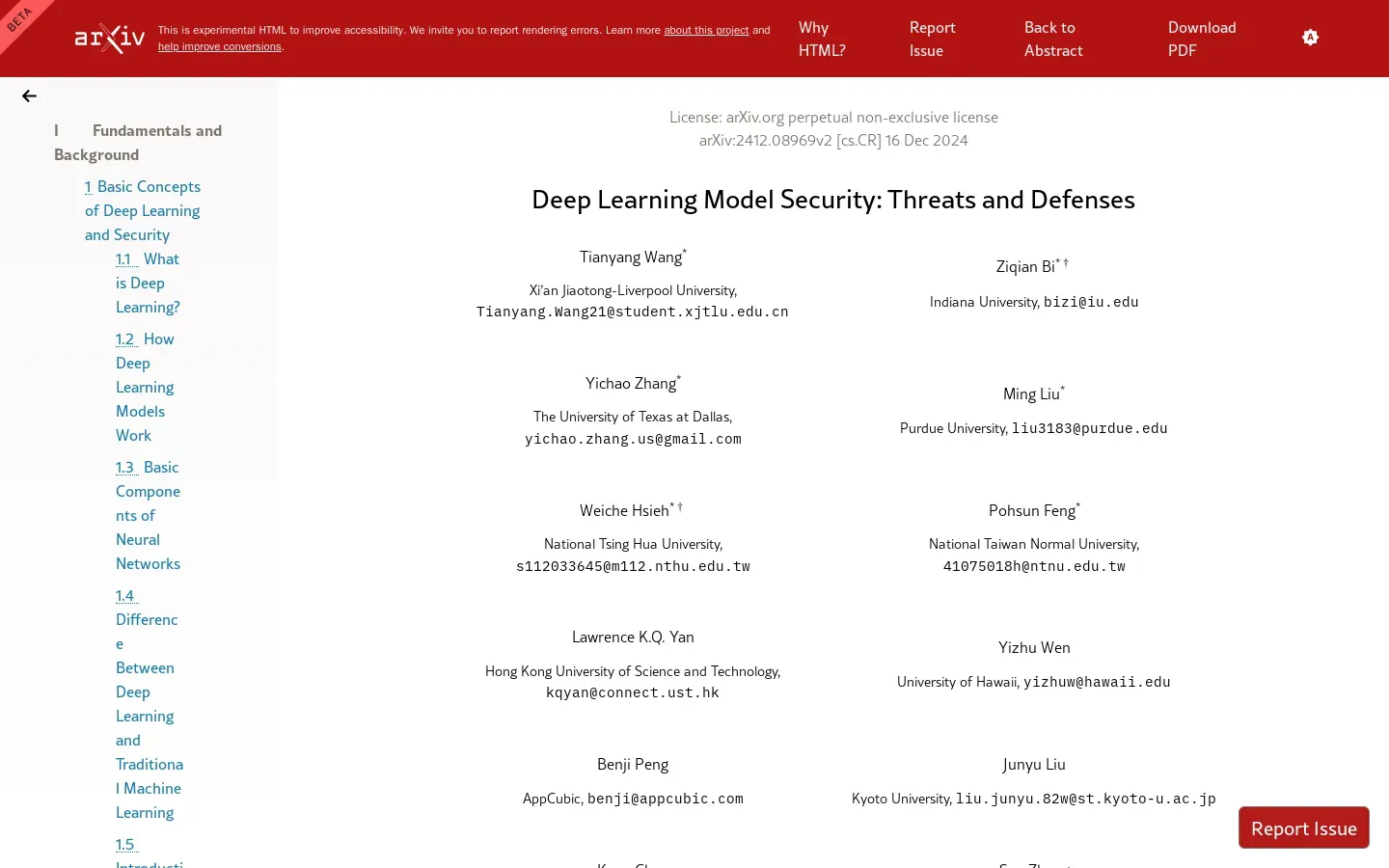
Deep Learning Security: Identifying Threats and Defenses
/ 4 min read
Quick take - Recent research in deep learning security has identified vulnerabilities in machine learning models and proposed strategies to enhance their resilience against adversarial attacks, data privacy issues, and unauthorized access, highlighting the need for comprehensive security frameworks in AI applications.
Fast Facts
- Recent research highlights vulnerabilities in deep learning models and proposes strategies to enhance their security against adversarial attacks and data privacy issues.
- Key objectives include investigating differential privacy, improving model protection, and implementing robust security measures through structured methodologies.
- Findings reveal increased susceptibility to adversarial attacks, risks of intellectual property theft, and privacy concerns from model inversion attacks.
- Recommended tools for enhancing security include PyTorch, adversarial training techniques, and differential privacy methods.
- Future directions focus on advanced adversarial training, automated threat detection, privacy-preserving machine learning, and zero trust architectures for AI systems.
Advancements in Deep Learning Security Research: A Comprehensive Overview
Recent advancements in deep learning security research have unveiled significant insights into the vulnerabilities of machine learning models. This study not only identifies key threats but also proposes comprehensive strategies to enhance their resilience against adversarial attacks, data privacy issues, and unauthorized access. The findings pave the way for more secure AI applications across various sectors.
Key Objectives and Methodology
The primary objectives of this research include investigating differential privacy techniques, enhancing model protection against adversarial attacks, and implementing robust security measures for machine learning systems. The methodology comprises several structured steps:
- Literature Review and Threat Identification: An extensive review of existing literature was conducted to identify prevalent threats to deep learning systems.
- Experimental Framework Development: Researchers established a framework to systematically evaluate model performance under various attack conditions.
- Implementation of Defense Mechanisms: Techniques such as adversarial training and differential privacy were developed and deployed to bolster model security.
- Performance Evaluation and Analysis: Rigorous testing and analysis were conducted to assess the effectiveness of implemented security measures.
Key Findings
The research yielded several crucial findings:
- Increased Vulnerability to Adversarial Attacks: Models are often susceptible to attacks designed to manipulate their predictions.
- Intellectual Property Risks: The potential for model theft poses significant risks to proprietary algorithms and data.
- Privacy Concerns: Issues arise from model inversion attacks, where sensitive training data could be exposed.
- Need for Comprehensive Security Frameworks: There is a clear demand for integrated approaches to safeguard machine learning systems.
Strengths and Limitations of the Research
This research is characterized by its systematic approach and robust methodologies. However, it faces limitations, including the need for more empirical testing across diverse real-world scenarios and the exploration of additional attack types. Areas for further investigation include longitudinal studies to evaluate the sustainability of security measures over time.
Recommended Tools and Frameworks
The research highlights several tools and techniques crucial for enhancing deep learning security:
- PyTorch: A flexible framework for developing deep learning models, facilitating the integration of security features.
- Adversarial Training: Techniques aimed at training models to withstand adversarial examples.
- Fast Gradient Sign Method (FGSM): A method for generating adversarial examples to test model robustness.
- Differential Privacy: Techniques implemented via PyTorch’s Opacus library to protect sensitive data during training.
Future Directions and Applications
The findings suggest several promising avenues for future research and real-world applications:
- Enhanced Adversarial Training Techniques: Developing more sophisticated adversarial training methods to improve model resilience.
- Automated Threat Detection Systems: Creating systems that can autonomously identify and respond to potential security threats in real time.
- Privacy-Preserving Machine Learning: Further exploration of differential privacy and federated learning to protect sensitive information.
- Zero Trust Architectures for AI Systems: Implementing security frameworks that assume no implicit trust and continuously verify users and devices.
Implications for Cybersecurity
The implications of this research extend to the broader field of cybersecurity, emphasizing the importance of integrating advanced learning techniques, encryption methods, and secure data pipelines to counter emerging threats. As machine learning systems become increasingly prevalent, the need for comprehensive security frameworks is more pressing than ever to safeguard against adversarial attacks, intellectual property theft, and privacy violations.
By addressing these vulnerabilities through strategic implementation of defense mechanisms, organizations can better protect their AI systems from evolving cybersecurity threats.



